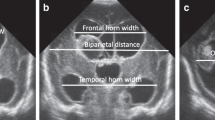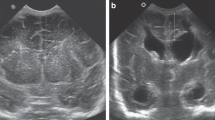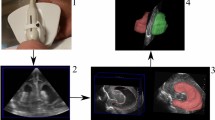Abstract
Objective:
To determine the incidence and factors associated with diffuse basal ganglia or thalamus hyperechogenicity (BGTH) in preterm infants.
Study Design:
(1) Review of serial neurosonograms among neonates with gestational age (GA) <34 weeks born at Weiler Hospital during a 21-month period; (2) Color Doppler flow imaging; (3) Case–control study using GA group-matched controls; and (4) Blind reading of CT scans or MRIs in patients with BGTH.
Results:
Among 289 infants, 24 (8.3%) had diffuse BGTH. Color Doppler flow imaging was normal in nine patients. The incidence of diffuse BGTH was inversely related to GA (P<0.01). Logistic regression (n=96) showed that diffuse BGTH was significantly associated with requirement of high-frequency oscillation (HFO) (P=0.031), severe intraventricular hemorrhage (IVH) (P=0.004), hypotension requiring vasopressors (P=0.040), hypoglycemia (P=0.031) and male gender (P=0.014). Most patients with diffuse BGTH had normal basal ganglia and thalamus on CT/MRI, one had a hemorrhage, and one had an ischemic infarction.
Conclusions:
In our series, diffuse BGTH occurred in 8.3%, and was associated with factors similar to those previously reported. In contrast, several series have reported almost exclusively linear or punctuate hyperechoic foci, corresponding to hyperechogenicity of the lenticulostriate vessels. Our data provide further evidence to suggest that diffuse BGTH and hyperechogenicity of the lenticulostriate vessels are two different entities. Additional studies are required to determine the long-term significance of diffuse BGTH.
This is a preview of subscription content, access via your institution
Access options
Subscribe to this journal
Receive 12 print issues and online access
$259.00 per year
only $21.58 per issue
Buy this article
- Purchase on Springer Link
- Instant access to full article PDF
Prices may be subject to local taxes which are calculated during checkout

Similar content being viewed by others
References
Teele RL, Hernanz-Shulman M, Sotrel A . Echogenic vasculature in the basal ganglia of neonates: a sonographic sign of vasculopathy. Radiology 1988; 169: 423–427.
Weber K, Riebel T, Nasir R . Hyperechoic lesions in the basal ganglia: an incidental sonographic finding in neonates and infants. Pediatr Radiol 1992; 22: 182–186.
Makhoul IR, Eisenstein I, Sujov P, Soudack M, Smolkin T, Tamir A et al. Neonatal lenticulostriate vasculopathy: further characterisation. Arch Dis Child Fetal Neonatal Ed 2003; 88: F410–F414.
Chamnanvanakij S, Rogers CG, Luppino C, Broyles SR, Hickman J, Perlman JM . Linear hyperechogenicity within the basal ganglia and thalamus of preterm infants. Pediatr Neurol 2000; 23: 129–133.
Leijser LM, Klein RH, Veen S, Liauw L, Van Wezel-Meijler G . Hyperechogenicity of the thalamus and basal ganglia in very preterm infants: radiological findings and short-term neurological outcome. Neuropediatrics 2004; 35: 283–289.
Paczko N, Rotta NT, Silva A, Leiria F . Hyperechogenicity of thalamic vessels in preterm newborn infants. J Pediatr (Rio J) 2002; 78: 371–374.
Cabanas F, Pellicer A, Morales C, Garcia-Alix A, Stiris TA, Quero J . New pattern of hyperechogenicity in thalamus and basal ganglia studied by color Doppler flow imaging. Pediatr Neurol 1994; 10: 109–116.
Barkovitch AJ . Toxic and metabolic brain disorders. In: Barkovitch AJ (ed). Pediatric Neuroimaging, 3d Edn. Lippincott: Williams & Wilkins, 2000, pp 71–156.
Schlesinger IE, Shackeldorf GD, Adcock LM . Hyperechoic caudate nuclei: a potential mimic of germinal matrix hemorrhage. Pediatr Radiol 1998; 28: 297–302.
de Vries LS, Groenendaal F, Eken P, van Haastert IC, Rademaker KJ, Meiners LC . Infarcts in the vascular distribution of the middle cerebral artery in preterm and fullterm infants. Neuropediatrics 1997; 28: 88–96.
Serrano M, Esteban I, Morales C, Pellicer A, Valverde E, Madero R et al. Where is brain injury located in very low birth weight infants (VLBW) infants?: A Cranial Ultrasound (CUS) and Neuropathological (NP) Study. Pediatr Res 2003; 53: 450A.
Cabanas F, Pellicer A, Valverde E, Morales C, Quero J . Central nervous system vasculopathy in neonatal lupus erythematosus. Pediatr Neurol. 1996; 15: 124–126.
Tagarro A, Garcia-Alix A, Alarcon A, Hernanz A, Quero J . Congenital syphilis: beta2-microglobulin in cerebrospinal fluid and diagnosis of neurosyphilis in an affected newborn. J Perinat Med. 2005; 33: 79–82.
Mittendorf R, Kuban K, Pryde PG, Gianopoulos JG, Yousefzadeh D . Antenatal risk factors associated with the development of lenticulostriate vasculopathy (LSV) in neonates. J Perinatol 2005; 25: 101–107.
Mittendorf R, Covert R, Pryde PG, Lee KS, Ben-Ami T, Yousefzadeh D . Association between lenticulostriate vasculopathy (LSV) and neonatal intraventricular hemorrhage (IVH). J Perinatol 2004; 24: 700–705.
Hemachandra AH, Oravec D, Collin M, Tafari N, Mhanna MJ . Early and late postnatal identification of isolated lenticulostriate vasculopathy in preterm infants: associated findings. J Perinatol 2003; 23: 20–23.
Coley BD, Rusin JA, Boue DR . Importance of hypoxic/ischemic conditions in the development of cerebral lenticulate vasculopathy. Pediatr Radiol 2000; 30: 846–855.
Gourment C, Decortis T, Rigo J . Hyperechogenicity within the basal ganglia of neonates: incidence, etiology, neurological outcome. Rev Med Liege; 2003; 58: 761–764.
Wang H, Kud M, Chang T . Sonographic lenticulostriate vasculopathy in infants: some associations and a hypothesis. Am J Neuroradiol 1995; 16: 97–102.
Koopman-Esseboom C, Stoutenbeek P, Groenendaal F, Nikkels P, de Vries LS . Morbidity and Mortality in TTTS TWINS. Pediatr Res 2000; 47: 315A.
Dogra VS, Menon PA, Poblete J, Smeltzer JS . Neurosonographic imaging of small-for-gestational-age neonates exposed and not exposed to cocaine and cytomegalovirus. J Clin Ultrasound 1994; 22: 93–102.
Govaert P, Lequin M, Swarte R, Robben S, De Coo R, Weisglas-Kuperus N et al. Changes in globus pallidus with (pre)term kernicterus. Pediatrics 2003; 112: 1256–1263.
Barkovich AJ, Sargent SK . Profound asphyxia in the preterm infant: imaging findings. AJNR Am J Neuroradiol 1995; 16: 1837–1846.
El Ayoubi M, de Bethmann O, Monset-Couchard M . Lenticulostriate echogenic vessels: clinical and sonographic study of 70 neonatal cases. Pediatr Radiol 2003; 33: 697–703.
Ashraf VS, Feldstein VA, Filly RA . Variation in echogenicity of the basal ganglia: anisotropic effect. J Ultrasound Med 1999; 18: 153–158.
Papile LA, Burstein J, Burstein R, Koffler H . Incidence and evolution of subependyma and intraventricular hemorrhage: a study of infants with birth weights less than 1,500?gm. J Pediatr 1978; 92: 529–534.
Wiswell TE, Graziani LJ, Kornhauser MS, Stanley C, Merton DA, McKee L et al. Effects of hypocarbia on the development of cystic periventricular leukomalacia in premature infants treated with high-frequency jet ventilation. Pediatrics 1996; 98: 918–924.
Cowan FM, Ricci D, Bassi L, Dubowitz L, Mercuri E, deVries L et al. Neonatal Stroke – How Well Can Abnormality Seen on Brain MRI Be Detected Using Cranial Ultrasound? Pediatr Res 2004; 55: 423A.
Maalouf EF, Duggan PJ, Counsell SJ, Rutherford MA, Cowan F, Azzopardi D et al. Comparison of findings on cranial ultrasound and magnetic resonance imaging in preterm infants. Pediatrics 2001; 107: 719–727.
Hughes P, Weinberger E, Shaw DWW . Linear areas of echogenicity in the thalami and basal ganglia of neonates: an expanded association. Work in progress. Radiology 1991; 179: 103–105.
Wang HS, Kuo MF . Sonographic lenticulostriate vasculopathy in infancy with tic and other neuropsychiatric disorders developed after 7 to 9 years of follow-up. Brain Dev 2003; 25 (Suppl 1): S43–S47.
De Vries LS, Gunardi H, Barth PG, Bok LA, Verboon-Maciolek MA, Groenendaal F . The Spectrum of Cranial Ultrasound and Magnetic Resonance Imaging Abnormalities in Congenital Cytomegalovirus Infection. Neuropediatrics 2004; 35: 113–119.
Roelants-van Rijn AM, Groenendaal F, Beek FJA, Eken P, van Haastert IC, de Vries LS . Parenchymal Brain Injury in the Preterm Infant: Comparison of Cranial Ultrasound, MRI and Neurodevelopmental Outcome. Neuropediatrics 2001; 32: 80–89.
Mercuri E, Atkinson J, Braddick O, Anker S, Cowan F, Rutherford M et al. Basal ganglia damage and impaired visual function in the newborn infant. Arch Dis Child Fetal Neonatal Ed 1997; 77: F111–F114.
Mercuri E, Anker S, Guzzetta A, Barnett AL, Haataja L, Rutherford M et al. Visual function at school age in children with neonatal encephalopathy and low Apgar scores. Arch Dis Child Fetal Neonatal Ed 2004; 89: F258–F2562.
Acknowledgements
Preliminary results were presented at the following meetings: Mead Johnson Nutritionals Greater NY Conference on Perinatal Research, White Plains, NY, 13 October 2000; Annual Meeting of the Eastern Society for Pediatric Research Absecon, NJ, 18 March 2001; NY Perinatal Society, New York, NY, 22 May 2001 and 20 May 2003; 25th Greater NY Conference on Perinatal Research, Tarrytown, NY, 19 November 2003; Annual Meeting of the Eastern Society for Pediatric Research, Old Greenwich, CT, 27 March 2004; and Annual meeting of the American Academy of Pediatrics, San Francisco, CA, 9 October 2004. We wish to thank the parents who have agreed for their infants to participate in the study, Dr Deborah E Campbell for her help and support, Dr Solomon Moshé for reviewing the manuscript, and the whole NICU staff.
Author information
Authors and Affiliations
Corresponding author
Rights and permissions
About this article
Cite this article
Soghier, L., Vega, M., Aref, K. et al. Diffuse basal ganglia or thalamus hyperechogenicity in preterm infants. J Perinatol 26, 230–236 (2006). https://doi.org/10.1038/sj.jp.7211460
Received:
Revised:
Accepted:
Published:
Issue Date:
DOI: https://doi.org/10.1038/sj.jp.7211460
Keywords
This article is cited by
-
Gray-scale ultrasound findings of hypoxic-ischemic injury in term infants
Pediatric Radiology (2021)



